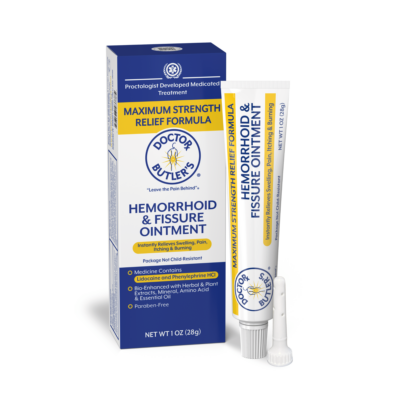We love hemorrhoid jokes as much as the next brand, but being the butt of every joke gets old when we have some real-deal advice to share! What does a hemorrhoid actually feel like, and how do I know if I have one? Not exactly sure? Doctor Butler’s has you covered. In this post, we’ll define what a hemorrhoid is, what causes them to occur, and most importantly, how they actually feel.
Skip right to the section on what hemorrhoids feel like by clicking here: What do hemorrhoids feel like?
It’s tricky to treat something you’re not even sure you have, so read on to get to the bottom of what hemorrhoids feel like. Know you have hemorrhoids and need quick relief? Try our award winning, proctologist-made ointment!
Very helpful
Very helpful
Verified ReviewerWhat are Hemorrhoids?
First things first, what are hemorrhoids? Hemorrhoids, put simply, are swollen veins that exist around the anus and lower portion of your rectum. Hemorrhoids, also called piles, are found both internally and externally. They occur when the walls of our veins begin to weaken, inhibiting proper blood flow and causing the blood to pool and then bulge. Everyone contains hemorrhoidal tissue, thus it should come as no surprise that approximately half of adults over 50 will be impacted by problematic hemorrhoids.
What are the Common Causes of Hemorrhoids?
Hemorrhoids are common for a reason. Much of what spurs the formation of both internal and external hemorrhoids are the result of actions we may take every day, such as sitting on the toilet for long periods of time (put the phone down!) or eating a low-fiber diet. Those who suffer from chronic constipation or diarrhea and anyone who’s ever experienced straining during bowel movements are at higher risk of hemorrhoids. This can include those dealing with complications from diseases such as diabetes, with 60% of long-term diabetes patients experiencing constipation as a result. Any disease that entails nerve damage and the ensuing interference with the digestive tract is at higher risk for hemorrhoids. Pregnancy is also a leading cause of hemorrhoid sufferers, with a high amount of pregnant women affected by the condition. If you thought you were alone, think again. Hemorrhoids happen, so let’s get to the bottom of that question, what do hemorrhoids look and feel like?
What Do Hemorrhoids Feel Like?
As mentioned earlier, hemorrhoids occur both internally and externally. Internal and external hemorrhoids feel different in a number of ways, which we’ll explain more about. For further information on the two types of hemorrhoids, you can check out our resource page explaining the difference:
Keep reading to determine which type of hemorrhoids you may be experiencing and how Doctor Butler’s recommends dealing with those pesky and painful symptoms.
External Hemorrhoids
External hemorrhoids are typically the painful ones, so if you’re already asking yourself whether you have hemorrhoids based on current symptoms, it is likely you are feeling the effects of external hemorrhoids. So, what do external hemorrhoids feel like exactly? For starters, they’re visible, and those painful, swollen lumps are behind the anal pain that increases upon sitting down to pass a bowel movement.
The lumps make it feel as though something is pushing against the anus, making it uncomfortable to sit. The added crevasses created by the lumps can also make it more challenging to properly clean the area, leading to anal itching.
What do hemorrhoids feel like when pooping? Added pain and pressure and the sense of skin protruding during a bowel movement all come with the territory when we’re talking external hemorrhoids. As the swollen lumps are sensitive, both the bowel movement itself and the use of toilet paper to wipe up the area put you at risk for increased irritation.
Internal Hemorrhoids
What do internal hemorrhoids feel like? The key difference between internal and external hemorrhoids is a matter of nerve endings. Where external hemorrhoids immediately present exposed nerves, unless internal hemorrhoids become prolapsed and push outside the anal opening, you are less likely to detect them based on feeling alone.
You may notice blood on your toilet paper or in the toilet bowl after a bowel movement, also called spotting. This indicates that the internal hemorrhoid has ruptured and is leaking out of the anus. Should the internal hemorrhoid swell without rupturing, the ensuing pressure may feel like the urge to have a bowel movement. As mentioned earlier, if an internal hemorrhoid becomes prolapsed via a strained bowel movement, the exposed hemorrhoid may cause pain and swelling until it is treated or returns inside the anal opening.
What Do Hemorrhoids Feel Like When You’re Sitting
As we discussed above, hemorrhoids can occur without us even noticing, particularly internal hemorrhoids, which generally exhibit painless symptoms that are easy to miss unless you catch blood on toilet paper after a bowel movement. The seated position, whether on the porcelain throne or working from home, is go-time for hemorrhoid symptoms, which can begin to act up just as soon as you decide to sit down. Below you will find a list of the most frequent signs and symptoms you can expect when dealing with internal or external hemorrhoids:
- Bleeding or spotting (often painless)
- Burning
- Discomfort
- Itching
- Pain during bowel movements
- Anal swelling
Hemorrhoid Treatment
While hemorrhoids are a true pain in the butt, the good news is that there are plenty of options for relief. These options span the spectrum from at-home remedies to surgery, and below, we’ll provide you with the information you need on where to start and when it’s time to seek medical attention for the treatment of internal or external hemorrhoids alike.
Hemorrhoids During Pregnancy
One population particularly prone to hemorrhoids is that of pregnant women, with nearly a majority of all women experiencing hemorrhoids at some point during their pregnancy. Given that changes in hormones and carrying extra weight are both known causes of hemorrhoids, it should come as no surprise that they are a common facet of pregnancy. An increase in pressure on both the pelvic area and lower digestive tract causes the veins in the anus to take-on some of this added impact, leading to swelling and the potential for hemorrhoids.
In addition to the extra weight of the fetus on the pelvis and digestive tract, the body is tending to additional blood flow, causing the veins to work harder than they’re typically used to. In terms of the veins found in and around the anus, this again makes conditions ripe for hemorrhoids.
Constipation, another leading cause of hemorrhoids, usually increases during pregnancy as hormone changes slow the digestive system, responsible for regulating bowel movements. In addition to the recommended treatments listed below, hemorrhoids due to pregnancy can be greatly aided by laying down whenever possible, particularly during the third trimester, when standing or sitting for too long puts the greatest strain on the body.
At-Home Treatments
Once you determine that you have hemorrhoids, there are plenty of places to start in terms of at-home treatment methods. Making sure you are eating a high-fiber diet including fruits, vegetables and whole grain foods will help keep stools soft and easier to pass. Consuming the daily recommended amount of water will also help support the body’s absorption of the fiber as it moves through the digestive system.
A sitz bath is another easy at home treatment. From the German word sitzen, to sit, a sitz bath is simply taking a bath or soaking in warm water for 10 to 20 minutes. This will relax the anal sphincter and promote increased blood flow to the surrounding tissue, providing relief from the itching, swelling or pain that can accompany hemorrhoids.
If the symptoms still persist, you can then try a number of different over-the-counter products with ingredients that aim to relieve discomfort as hemorrhoid swelling subsides. In many cases, medicated ointments and sprays will treat hemorrhoid symptoms faster than natural products alone.
Common components of topical treatments like ointments, creams and sprays include witch hazel, lidocaine, hydrocortisone and other active ingredients with the goal of short-term, local relief from hemorrhoids. Take a peek below at just some of the products Doctor Butler’s offers as a pioneer in the at-home hemorrhoids treatment market:
Medical Procedures
If you’ve tried a number of at-home treatments and your hemorrhoids show no sign of subsiding, it’s time to consult a medical professional, who will weigh in on the appropriate next steps for your particular situation. Two medical procedures that primarily target internal hemorrhoids are rubber band ligation and sclerotherapy, which rely on the use of scar tissue to cut-off blood supply and shrink the remaining hemorrhoid.
In rubber band ligation, a rubber band is placed around the base of the prolapsed hemorrhoid, which will shrivel and eventually fall off without the blood flow to sustain it. The scar tissue that forms in its place shrinks the remaining hemorrhoid. Sclerotherapy involves the injection of scar tissue directly into the internal hemorrhoid, producing the same loss of blood flow and again shrinking the hemorrhoid.
There are two surgical methods for the removal of hemorrhoids, a hemorrhoidectomy and a hemorrhoidopexy. Hemorrhoidectomies are used to surgically cut-out large external or prolapsed internal hemorrhoids that are unresponsive to alternative treatment. A hemorrhoidopexy involves stapling a prolapsed hemorrhoid back into the rectum, shrinking the hemorrhoid so that the tissue can be reabsorbed. Both surgical methods require the use of anesthesia and a period of recovery following the procedure.
Leave the Pain Behind with Doctor Butler’s Hemorrhoid Remedies
Dealing with hemorrhoids can mean a lot of different symptoms, none of which feel pleasant. We hope this article has given you the confidence that you are not alone in facing these flare-ups. When it comes to hemorrhoids, knowledge is power, and identifying how and what you’re feeling is the first step to seeking relief.
Many routine parts of daily living can contribute to the formation of internal and external hemorrhoids, but by identifying risk factors and finding room for adjustments, we can begin to lessen their occurrence. Doctor Butler’s line of over-the-counter products provides additional support when lifestyle changes don’t garner adequate results. And, as always, we recommend seeking the advice of a medical professional if your hemorrhoids persist for more than two weeks after beginning treatment.
References:
https://medlineplus.gov/hemorrhoids.html
https://www.niddk.nih.gov/health-information/digestive-diseases/hemorrhoids/definition-facts

